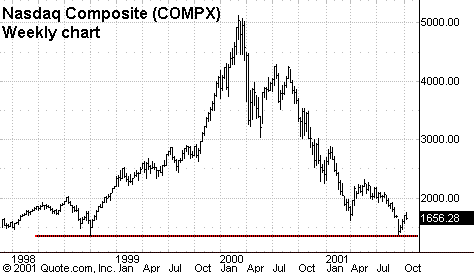From The Long-Term Perspective
As the
analyst crowd continues to hammer away at tech with downgrades and
negative comments, it’s easy to buy into the despair and write off the entire
tech sector forever. With three years of stellar returns completely erased, most
tech investors wonder what the heck we were all thinking during the boom time.
It’s easy to rationalize the
whole time as just a crazy bubble fueled by nothing but hype and hot air (and
boy was there a lot of hot air!), but there really were revolutionary changes
that took place that will pave the way for the next leg up in tech.
Sure, the dot-com portion of
the recent boom was insane, but few tech followers would have thought the tech
collapse would take down the entire telecom industry, as well as every other
tech sector. It was especially painful because many of the “real” and
profitable long-term companies — Lucent
(
LU |
Quote |
Chart |
News |
PowerRating), WorldCom
(
WCOM |
Quote |
Chart |
News |
PowerRating), Tellabs
(
TLAB |
Quote |
Chart |
News |
PowerRating) — got crushed.
So what is next for tech? Well,
Sept. 11 certainly will prolong any recovery, but it has been very constructive
that the Nasdaq managed to bounce back nicely after coming very close to its
October 1998 lows. The fact that the Nasdaq has held on to its recent gains,
despite all the terrorism scares and economic worries, is also a big plus. In
addition, new bull markets are born out of despair, and the tech sector
certainly qualifies as a sector in heavy despair.

It’s also helpful to take a
longer-term view of techland in order to put the 18-month collapse in
perspective. While the Nasdaq may have fallen to three-year lows, it still
managed to remain relatively on par with the broader market if we look back five
years. In fact, looking at five-year returns of top tech performers as well as
the major averages helps put some of the tech collapse in perspective.
For example, even at its
post-collapse levels, the Nasdaq 100 has a five-year total return of 79%. The
Nasdaq composite has not fared as well and has a five-year total return of just
35%. By comparison, the Dow posted a five-year return of 53%, and the S&P
500’s five-year return is 52%. So on a relative basis, tech has not done that
bad over the long haul. (I know this is a stretch, but believe me, it’s been
hard to find ANYTHING positive to say about tech for a long time!)
Another interesting set of
returns showed up within these five-year returns when I looked at some of the
individual leaders in terms of five-year performance. Among the top techs for
five-year total returns (even after the 18-month meltdown) were Qualcomm
(
QCOM |
Quote |
Chart |
News |
PowerRating),
up 918%, Dell Computer
(
DELL |
Quote |
Chart |
News |
PowerRating), up 802%, Mercury Interactive
(
MERQ |
Quote |
Chart |
News |
PowerRating), up
602%, Flextronics
(
FLEX |
Quote |
Chart |
News |
PowerRating), up 569%, and (for you Net fans) Yahoo
(
YHOO |
Quote |
Chart |
News |
PowerRating),
up 560%. Also very strong was eBay
(
EBAY |
Quote |
Chart |
News |
PowerRating), which went public a little over
three years ago and still looks great.
Further down the list were more
of the fallen-angel big-cap giants that were once so loved by techies. These
high-profile names (and five-year performances) include Microsoft
(
MSFT |
Quote |
Chart |
News |
PowerRating),
up 233%, Oracle
(
ORCL |
Quote |
Chart |
News |
PowerRating), up 203%, JDS Uniphase
(
JDSU |
Quote |
Chart |
News |
PowerRating), up 179%, Cisco
(
CSCO |
Quote |
Chart |
News |
PowerRating),
up 154%, and Intel
(
INTC |
Quote |
Chart |
News |
PowerRating), up 83%.
While these long-term numbers
may not take the sting out of the tech collapse, they do show that owning the
leaders over a longer haul can (even in bad times) greatly top the major
averages. Now that we are more than 18 months into this crushing bear market
that has seen the Nasdaq fall 70% from its highs, tech investors are wondering
if the worst is over. The recent VIX and ARMs extreme readings and the extreme
despair levels seem to indicate that a bottom COULD be in place.
What’s next then? Well, we just
lived through the wildest capital spending orgy the world has ever seen, and
while trillions of dollars in market cap vanished into thin air, think of what
it left in its wake. Pipes were dug, fiber-optic cable was laid worldwide, we
nearly got the planet connected (except we all still have slow and worthless
dial-up AOL at home), and now we just have to figure out what the next wave will
be.
Will it be wireless? Or
opticals? Or new software? What will be the next Killer App? I have no idea, but
it probably has some strange scientific name that no one has heard of yet (like
“telematics,” for example). Anyway, it’s that mystery and newness that
makes tech investing so challenging. I do know, however, that whatever the next
wave is, it will be BIG, and it will make the Net Boom look like a tea party.
Have a great weekend!
Dan
